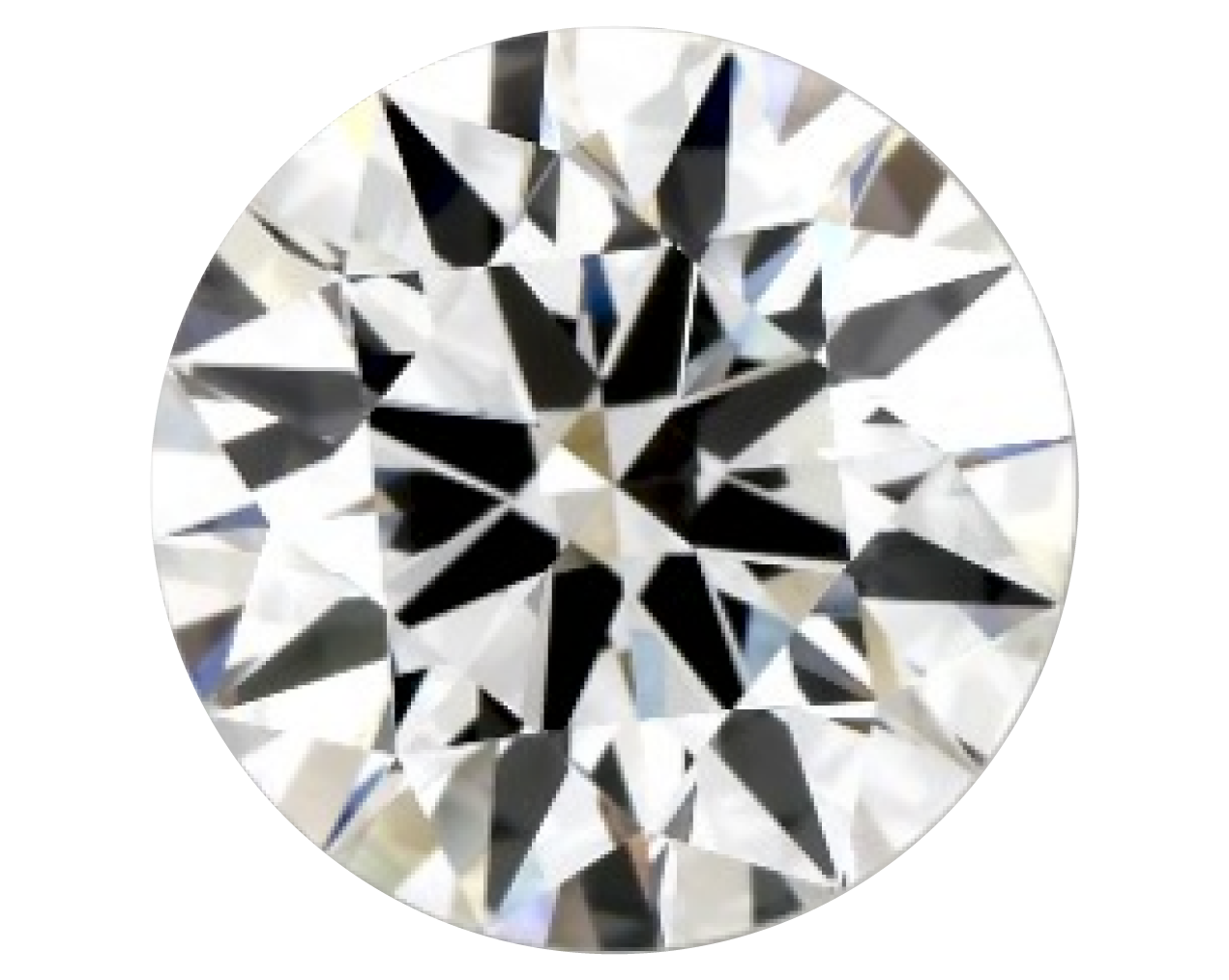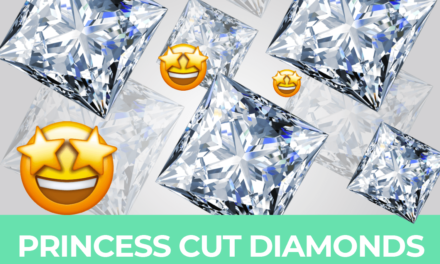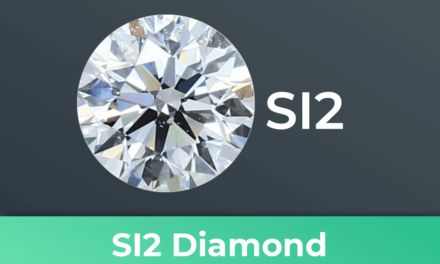My website is reader-supported. Buying through links on my site may result in me earning a CUSTOMER REFERRAL FEE at no extra cost to you.
Check out the latest deals at our top diamond vendor choice: James Allen
The Optimal Diamond Clarity Grade For Your Engagement Ring
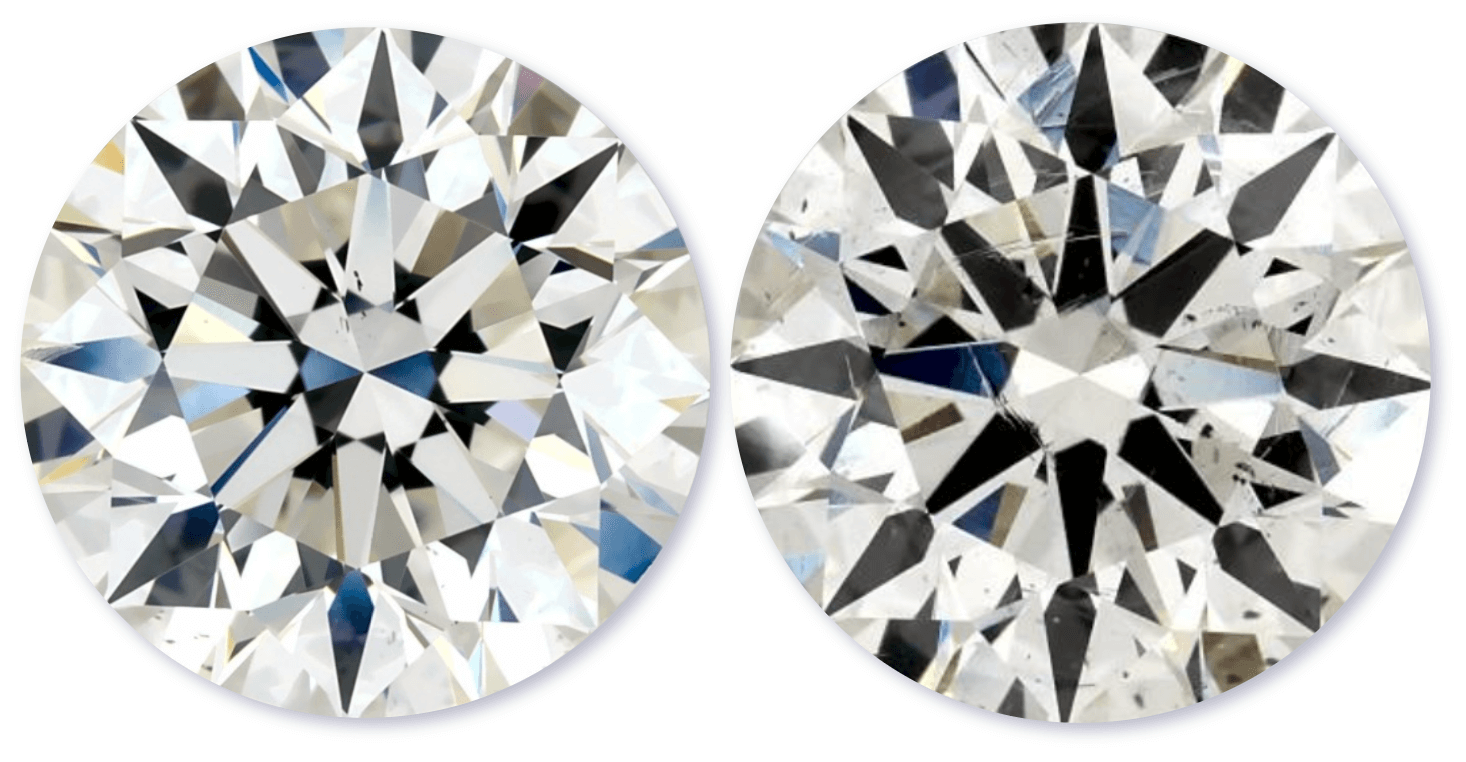
If you’re in the market for an engagement ring, you’ve likely heard a thing or two about diamond clarity. But what does that term mean? And why is it important?
In this blog post, we’ll break down everything you need to know about diamond clarity, so you can make an informed purchase when shopping for your fiancee’s ring. Keep reading to learn more!
Content overview
- What is diamond clarity?
- The GIA grading scale
- Who grades diamonds and how?
- How diamond shape, size, and color affect diamond clarity
- Why you shouldn’t buy the highest clarity grade
- What is the difference between blemishes and inclusions?
- The best diamond clarity for an engagement ring
- How and where to find and buy eye-clean diamonds
- Diamond quiz: Can you spot the difference?
VVS1 Diamond Summary
- Diamond clarity refers to the presence or absence of flaws in a diamond; the fewer flaws (called inclusions and blemishes), the higher the clarity grade
- Eleven clarity grades are ranging from FL (flawless diamonds) to I3 diamonds (diamonds with visible inclusions)
- The higher the clarity grade, the more expensive the diamond
- Inclusions and blemishes can prevent light from freely moving through the diamond, thus, affecting the diamond’s sparkle; however, it is not necessary to purchase a diamond with a high clarity grade to get the maximum amount of sparkle
- You can find so-called eye-clean diamonds in lower clarity grades and save money if you make use of high definition pictures and videos
- Generally, if you opt for diamonds below 2 carats and a traditional round brilliant cut or a princess cut, you can opt for lower clarity grades, whereas higher clarity grades might be required for step cut diamonds such as Emerald or Asscher, as well as very large diamonds
- The best places to shop for VVS1 or lower clarity grade diamonds are James Allen and Blue Nile
WHAT IS DIAMOND CLARITY?
Diamond clarity refers to the presence or lack of flaws in a diamond.
Clarity is graded on a scale from FL (a flawless diamond) to I3 (a diamond with visible flaws), with diamond grades progressing as the diamond becomes more clear and transparent.
The GIA (Gemological Institute of America) created the most popular diamond clarity scale, a diamond rating agency that grades diamond color and diamond clarity, among other diamond characteristics.
Below is an example of a diamond with severe inclusions and a diamond that is considered eye clean (i.e., no inclusions visible to the unaided eye).
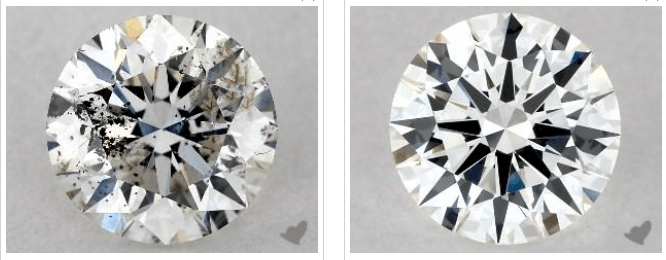
The diamond’s clarity also plays an important factor in its market value. As you can see in the graphic below, the price increases with each clarity grade:
You might be wondering why diamond clarity is so important. After all, some inclusions can make a diamond unique. And I agree. However, depending on the location, certain inclusions can hinder the light from freely traveling through the diamond’s body, diminishing its overall sparkle.
However, that doesn’t mean you have to opt for the highest or a high clarity grade to get the maximum sparkle.
Many people don’t know that two diamonds of different clarity grades can look almost the same but have a different price tag.
I’ll teach you exactly how to find such a diamond and where in later sections. But first, let’s take a look at the individual clarity grades.
THE VARIOUS DIAMOND CLARITY GRADES ON THE DIAMOND CLARITY SCALE
The GIA is a leading diamond grading institution, as mentioned in the previous section. This institution is one of the leading diamond graders for natural diamonds and lab-created diamonds.
When shopping for a diamond ring, I’d always recommend looking for GIA-certified diamonds or IGI certified diamonds. Both scan loose diamonds for noticeable inclusions under a magnifying glass and grade the diamonds accordingly. Reputable vendors such as James Allen or Blue Nile provide grading reports from those institutions for all of their diamonds.
You can find a diamond clarity scale from GIA below:
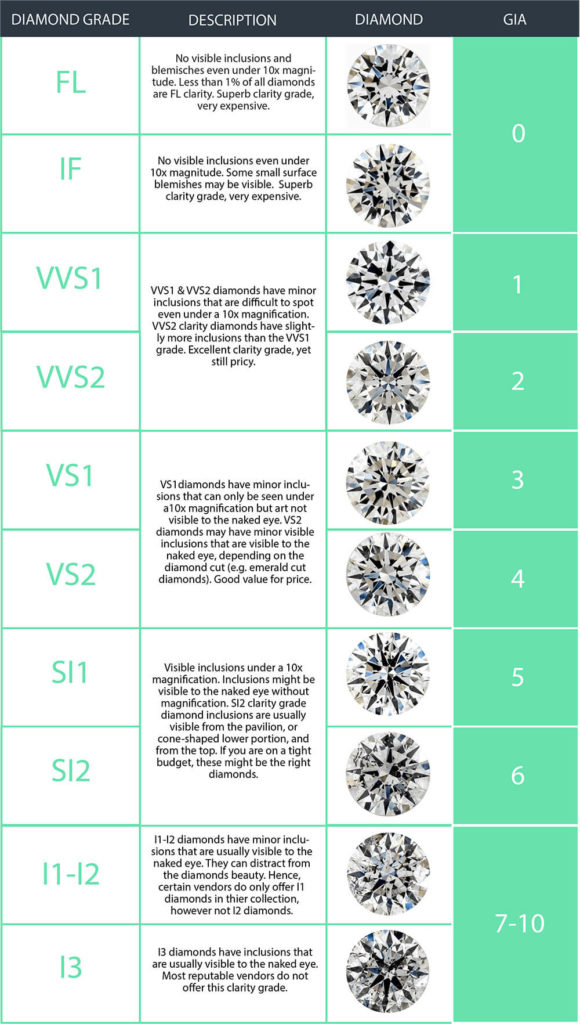
Diamond clarity chart
- FL diamonds (flawless fl) – No visible inclusions and blemishes even under 10x magnitude. Less than 1% of all diamonds are FL clarity. Superb clarity grade, very expensive.
- IF or internally flawless diamonds – No visible inclusions even under 10x magnitude. Some small surface blemishes may be visible. Superb clarity grade, very expensive.
- VVS1 & VVS2 or very very slightly included – VVS1 diamonds have minor inclusions that are difficult to spot even under a 10x magnification. VVS2 clarity diamonds have slightly more inclusions than the VVS1 grade. Excellent clarity grade, yet still pricy.
- VS1 & VS2 or very slightly included diamonds – VS1 diamonds have minor inclusions that can only be seen under a 10x magnification but are not visible to the naked eye. VS2 diamond’s inclusions can be visible to the naked eye, depending on diamond cut and location (e.g. emerald cut diamonds). Good value for the price.
- SI1 & SI2 or slightly included diamonds – Slightly included diamonds with inclusions visible under a 10x magnification. Small inclusions might be visible to the naked eye without magnification. SI2 clarity grade diamond inclusions are usually visible from the pavilion, or cone-shaped lower portion, and from the top. If you are on a budget, these might be the right diamonds!
- I1, I2, I3 or included diamonds – These diamonds have significant inclusions and blemishes that are usually visible to the naked eye. They can distract from the diamond’s beauty. Hence, certain vendors do not offer any clarity grades below I1 in their collection.
HOW ARE DIAMONDS GRADED AND WHO GRADES THEM?
When grading a diamond’s clarity, there are five grading factors that jewelers consider:
- size of inclusions
- number of inclusions
- position of the inclusions
- types of inclusions
- color & relief of the inclusions
For instance, some inclusion and blemishes are so small that you can hardly see them, whereas other, larger ones are visible to the naked eye. Visible inclusions generally lead to a lower clarity grade of a diamond.
Interestingly, a lower graded diamond may look better to the naked eye than a higher graded diamond. Just take a look at the two diamonds below:
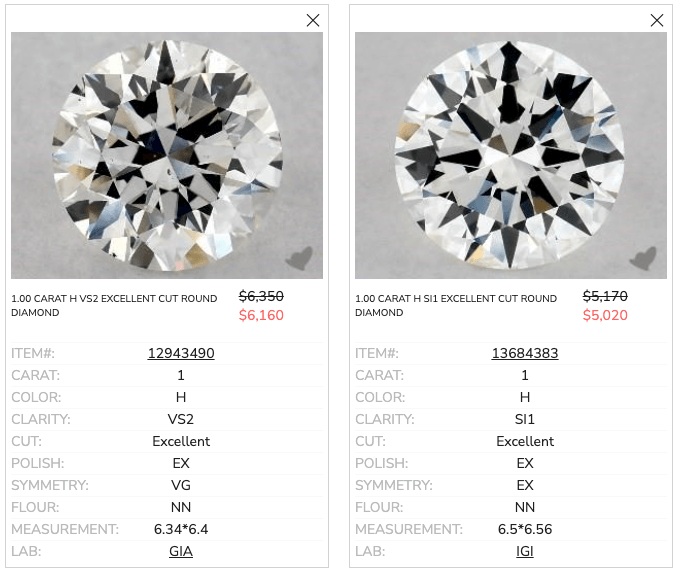
The one on the left has a higher clarity grade than the one on the left. Neither of them have very noticeable inclusions, but there’s a clear difference in the price!
HOW THE DIAMOND SHAPE, SIZE AND COLOR AFFECTS CLARITY GRADE
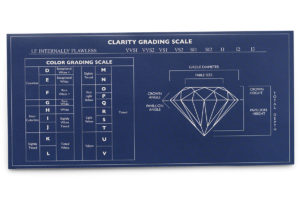
Not all diamonds are cut in the same way. There are many different diamond cuts you can choose from, such as emerald-, princess- or round cut diamonds.
The cut affects the clarity so that you would need a higher clarity grade in some instances and can opt for lower grades in others. For example, if you opt for step cuts (such as an Emerald cut) which emphasize transparency and let you see farther down into the diamond, then you’d often need to choose a higher clarity grade.
Other diamond cuts, such as the oval, princess, or round cut diamonds, naturally reflect more light and thus camouflage certain inclusions better. Hence, you can purchase a lower clarity grade.
In addition to that, the size of the diamond affects which clarity grade you should buy. Larger diamonds have larger facets and thus show off more what’s inside of the diamond. As a rule of thumb, you should, therefore, buy a higher clarity grade the bigger the diamond gets.
Another factor you want to consider is the diamond color. In general, the better the color grade, the less visible are inclusions and blemishes, as the diamond’s reflection will be stronger.
WHY YOU SHOULDN’T BUY THE HIGHEST DIAMOND CLARITY GRADE
Before we dive into more details, I want to tell you something. You probably already know that the higher the clarity of a diamond, the more expensive the diamond.
If there’s only one thing you are taking away from this blog post, let it be that you don’t need to buy the highest grade.
Many jewelers don’t tell you that a diamond with a high clarity grade is not necessarily more beautiful than one with a lower one. They can look identical!
Here’s an example:
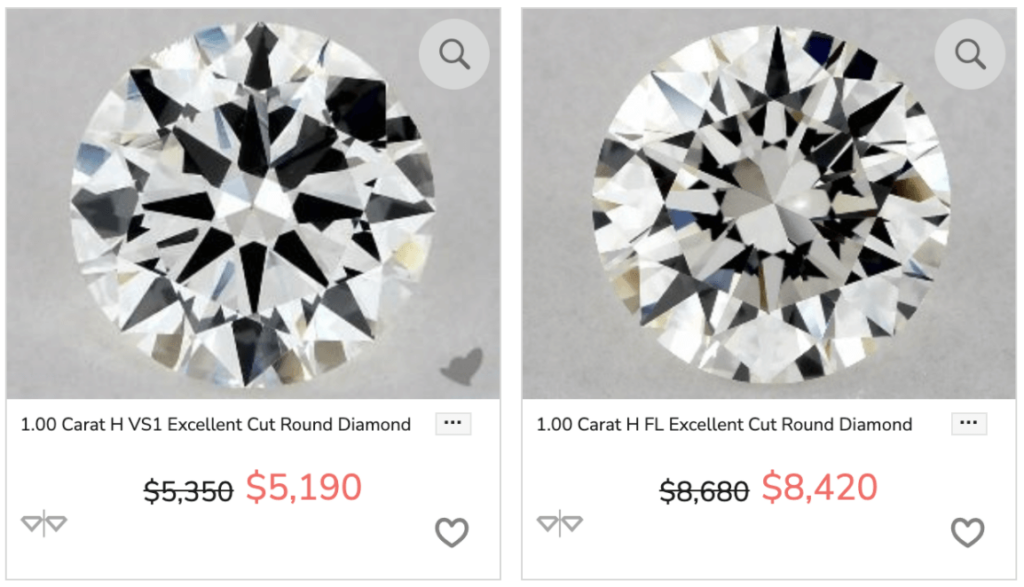
The diamond on the left has a low clarity grade. The one on the right has a high clarity grade. While they differ in price, you can’t tell the two apart based on clarity.
Because these two diamonds have one thing in common: they are “eye-clean.”And this is where you can save a lot of money.
You need to search for low-clarity “eye-clean diamonds.” Those diamonds look flawless to the naked eye, even though they have inclusions and blemishes. But those are only visible under 10x magnification.
All you need to find high-quality but low clarity diamonds is a visual tool to see the details.
Currently, only two vendors offer sufficiently high-quality images to search for those diamonds.
One of them is James Allen. The other one is Blue Nile. Both vendors allow you to inspect each diamond carefully. That way, you can easily spot a diamond that’s stunning and affordable.
WHAT IS THE DIFFERENCE BETWEEN A DIAMOND’S INCLUSIONS AND BLEMISHES?
Inclusions are blemishes refer to external and internal characteristics that affect diamond clarity. In diamond jargon, the word “inclusion” means a characteristic inside a diamond affecting its appearance or durability.
Blemishes are external marks on the diamond’s surface. Most blemishes result from natural blemishes or accidental damage such as chips and scratches.
While you sometimes can polish away blemishes on the surface, you can’t do the same to inclusions.
Here’s an example of a diamond with inclusions but no blemishes:
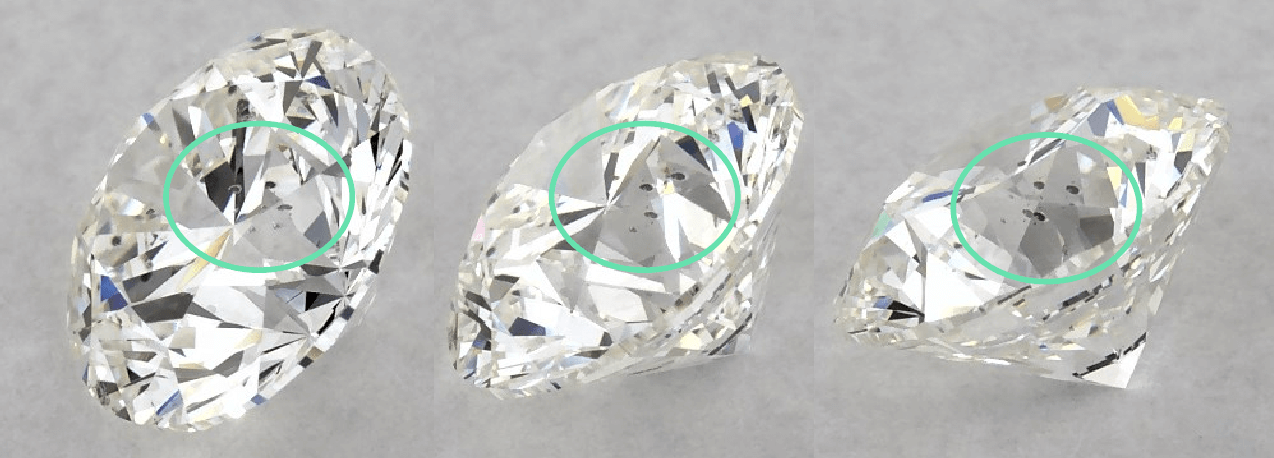 And here’s an example of a diamond with blemishes visible on the surface:
And here’s an example of a diamond with blemishes visible on the surface:

WHAT’S THE BEST DIAMOND CLARITY GRADE FOR A DIAMOND RING?
When looking for a loose diamond for your engagement ring, you want a sparkly and beautiful diamond.
On the one hand, you can pay too much money on an excellent color grade even though it doesn’t look any different from a lower diamond clarity. On the other hand, a clarity grade that is too low might diminish the diamond’s beauty.
In general, I recommend a clarity grading no lower than the following (except asher and emerald-cut diamonds):
VS 1, VS2, SI1, and SI2. These clarity grades can be flawless to the naked eye, thus not distracting from your diamond’s beauty.
Tip: If you want to get the very best value for your money, choose diamonds with a clarity grading like SI1 and SI2. Utilize James Allen’s 360-degree high-resolution pictures (with 10x magnification) and videos to detect where the inclusions are located.
With a little bit of time and effort, you will find many diamonds in this clarity range with inclusions in places where they aren’t directly visible, hence eye-clean.
If you intend to purchase an Emerald- or Asscher cut diamond with a carat weight larger than 1.5ct, I’d recommend going no lower than VS2.
BEST ONLINE SHOPS TO BUY YOUR DIAMOND RING
My absolute favorite online vendor for purchasing diamond engagement rings and loose diamonds is James Allen. One of the reasons is that James Allen has a great search machine to input all the characteristics of a diamond you are looking for. With their mega-zoom magnification tool, you can easily browse diamonds and pick the best option. James Allen will likely have a wide range of diamonds waiting for you for whatever diamond you are looking for.
Again, there’s no need to buy a flawless diamond. Diamond inclusions are not bad per se. You need to ensure that they don’t have any apparent inclusions.
Please feel free to reach out if you have any more questions about a specific grade, clarity characteristics, diamond inclusions, or clarity grading.
Diamond Quiz
Can you tell the difference?
One of the two diamonds below has a clarity grade of VVS1, the other one of VS1. Can you tell which one has the lower clarity grade and costs $1000 less?

